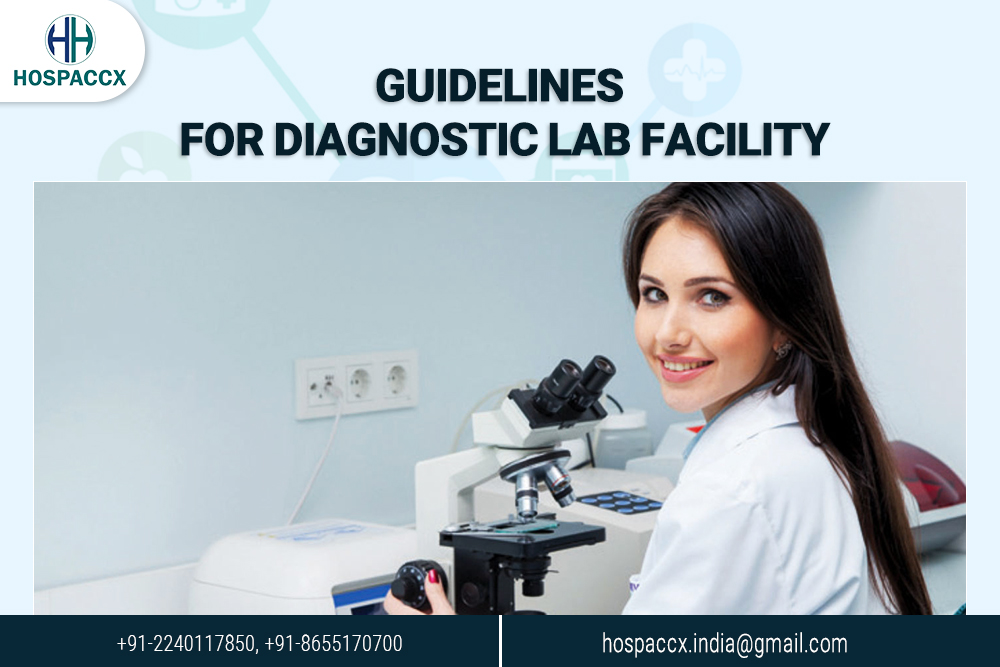Are you planning to build or restructure a Diagnostic lab in India? Looking for detailed information about the guidelines for diagnostic lab facility? In this article, Hospaccx Healthcare Consultancy has mapped and mentioned all the norms and guidelines required to set up a diagnostic lab. If you need any further assistance in designing diagnostic labs, or a refined market and financial feasibility, you can Contact Hospaccx Healthcare Consultancy Business on hospaccx.india@gmail.com
INTRODUCTION
The design of a laboratory facility can be a major factor in its success. A well-designed lab can be more efficient, quieter, more attractive and cheaper than one with design-related problems. There is not one correct laboratory design and avoiding many problems is a matter of combining engineering test experience with the construction experience of builders and architects. Visits to other labs and talks with their builders and designers can further improve your results.
Laboratories are needed for OPD, Emergency, and IPD patients. Most large public hospitals prefer to have separate self-contained laboratories unit exclusively for emergency patients; and the Main laboratories cater to both OPD and IPD patients. In case one laboratory is being planned; it should be easily approachable for all categories of patients. Ground or first floor is preferred, as about 60-65% of OPD patients need laboratory services along with 95-99% of indoor patients. In this era of automation, a single supervised lab with an efficient hospital information system circumvents the need for emergency laboratories.
The primary objective of laboratory design is to provide a safe environment for laboratory personnel to conduct their work. Therefore, all health and safety hazards must be identified and carefully evaluated so that protective measures can be incorporated into the design.
Laboratory or Facility Layout: This section discusses and illustrates the area requirement and spatial organization of each type of laboratory with special regard to egress, equipment and furniture locations, ergonomics, and ventilation requirements. Typical good practice layouts are illustrated, and a major effort is directed toward calling attention to those layouts that are undesirable. The location of exhaust hoods, biological safety cabinets, clean benches, and items of similar function are given special attention. Materials of construction are discussed concerning sustainability.
Heating, Ventilating, and Air-Conditioning: This section describes the desirable elements of a laboratory HVAC system that is designed for comfort and safety. This is needed because health and safety equipment installed in laboratories and laboratory buildings must perform its design function with a high level of reliability throughout an assigned service life that may be the same as the life of the building. Special attention is given to providing adequate makeup air for exhaust-ventilated facilities and to the pressure relationships between laboratories, offices, and corridors. When construction requirements for laboratory systems differ substantially from those that apply to ordinary HVAC installations, the differences are made explicit and appropriate codes and standards are cited in the text.
Architectural Considerations:
- Walls/Doors/Security: the laboratory must be completely separated from outside areas (i.e., must be bound by four walls). The laboratory shall have means of securing specifically regulated materials such as DEA Controlled Substances, CDC Select Agents and radioactive materials (i.e., lockable doors, lockable cabinets, etc.)
- Having secured hazardous materials storage will keep unauthorized personnel from gaining access to them. These regulations apply specifically to laboratories containing radioactive materials, CDC Select Agents and DEA Controlled Substances;
Doors in H-occupancy laboratories shall have doors that swing in the direction of egress. Doors serving B-occupancy shall swing in the direction of egress if the occupant load is 50 or more. Where possible, all B-occupancy lab doors should swing out with hardware satisfying ADA requirements. On the next to each door entry into the laboratory, an 8.5 x 11-inch space must be provided for a standardized clear frame with the room number and hazard warning sheet insert (landscape orientation). Each door into a laboratory room must have a view panel. Inside the laboratory, on the wall adjacent to the door latch, provide 2 feet of clear space for light switches, telephone, thermostat, and fire extinguisher. Vents are prohibited in laboratory doors which open to egress/access corridors. Laboratories that use hoods or other larger equipment should be equipped with doorways that have 48-inch openings. Each opening should accommodate a 36 active door leaf and a 12-inch inactive leaf.
- Path of workflow & Layout of the laboratory: Unidirectional workflow is important given productivity Management and infection control. 3 paths should be kept in mind. Sample Path, Reagent Path, and Report Path. The movement of personnel will be along all three and good planning will optimize this movement.
Sample Path
Reagent Path
Report Path
- Corridors: Internal Corridor width should be not less than 2550 mm. Corridors and passages to exits should be clear of obstructions.
- Ceilings: The minimum clear ceiling height in the laboratory should be 3000 mm.
- Entry to the laboratory: A lobby (buffer space) at each laboratory exit should form the boundary between the
- laboratory and non- laboratory space. This will allow for the hygienic, safe, and secure laboratory spaces. Provision of hand- washing facilities and coat pegs for hanging laboratory protective
- clothing should be provided in the lobby. Provision of storage space for linen bags for storing dirty protective clothing.
- Safety and Infection Control: Proper segregation between laboratories and non-laboratories.
- First-aid areas or rooms near laboratory suitably equipped and readily accessible should be
- available. An emergency tray to be available 24×7 with lifesaving drugs. A method and adequate space for decontaminating all laboratory wastes should be available
- In the facility (e.g., autoclave, chemical disinfection, or another validated decontamination method). The laboratory equipped with fire/emergency exits, and all fire exits lead to an open space
- outside. Specified locations for fire extinguishers, fire blankets should be available
- Security: The entire laboratory area should be planned as a secure area.
- Access should be restricted to authorized personnel.
- The whole laboratory securely locked when unoccupied.
- One security guard to be deputed during peak hours.
- Lighting: The laboratory should be illuminated to an optimal level (300 lux) for safe working. Glare
- should be minimized. Emergency lighting should be provided for corridors/exit pathways.
- Power back-up
- Spatial provision for equipment: Access to equipment for entry and maintenance: There should be no physical restrictions
- for access such as door and elevator size that could pose a problem for the delivery and maintenance of new machines and equipment. Optimum door width for all analytical/preanalytical spaces is considered. Power supply: Provision for round the clock stable power supply for sensitive equipment.
- A UPS power supply or emergency generator for laboratory facility be provisioned separately.
Following design guidelines need to be taken into consideration while designing a diagnostic lab:
- Flooring and Base Materials
- Floor materials should be non-absorbent, skid-proof, resistant to wear, and also resistant to the adverse effects of acids, solvents, and detergents in normal use.
- Flooring is monolithic or have a minimal number of joints such as vinyl composition tile (VCT) Floor surfaces should be easily cleanable and impervious to water. Joints in the flooring material should be kept to a minimum and sealed by hot welding. At wall junctions, the flooring should be coved to walls and sealed.
- Walls
- Wall surfaces should be free from cracks, unsealed penetrations, and imperfect junctions with ceiling and floors.
- Materials should be washable with strong detergents and disinfectants and be capable of withstanding the impact of normal traffic.
- Ceilings
- Ceilings such as washable lay-in acoustical tiles (with smooth surface) or any suitable suspended ceiling tiles should be provided for most laboratory spaces.
- Open ceilings are acceptable provided minimal ducting and piping is present and all exposed surfaces are smooth and cleanable.
- Windows and Window Treatment
- Energy-efficient glass in windows is recommended.
- Laboratory windows that open to the exterior are not recommended. However, if a laboratory does have windows that open to the exterior, they must be fitted with screens.
- Windows should be non-openable in sterile areas and should be sealed and caulked.
- Doors
- The minimum door width shall be 1200mm in all analytical areas, with double shutters. In laboratories where the use of larger equipment is anticipated, wider/ higher doors should be considered.
- Vision panels in doors are recommended for all. Pre-analytical/analytical areas
- High-touch fittings with copper finish are recommended.
- Self-closing doors are recommended to aid in infection control
- Laboratory doors should be recessed and swing outward in the direction of egress.
- The doors and windows of the laboratory to be security proof
- Access restriction to laboratories for example swipe cards or locks to control entry.
- Ergonomics features in Furniture /workstation /counters: Ergonomics gives a reasonable common base for design. Laboratory furniture should demonstrate good ergonomic design and must be compliant with local norms/standards. Following all items may consider following ergonomics in design.
a.) Workbenches
- A workstation intended for working, writing, or typing while in a seated position should be 720 mm high.
- The optimum recommended configuration for a workstation includes one worksurface of750 mm.
- Worksurface of 600 mm with the computer position in the corner. If a computer is positioned in the corner, then the corner should be angled with a minimum dimension of 400 mm.
- Workstation should have provision for safe cable management like provision of an open tray under the work surface.
- A counter to counter clearance of 2150 mm is recommended
- Workbenches should be made of non-absorbent materials, skid-proof, resistant to wear, and also resistant to the adverse effects of acids, solvents, and detergents in normal use.
- These should be monolithic or have a minimal number of joints between them which can sometimes harbor contaminating microorganisms.
- Organize workbenches according to the type of analysis that is performed, with adequate space for bench-tops equipment and enough space to place SOP while in use and display job aids.
- Provision for supply of water and disposal of drainage be made on and below the workbenches.
- Open spaces between and under benches, cabinets, and equipment should be accessible for cleaning.
b.) Furniture
- Lab furniture should be sturdy and ergonomically effective, for long usage.
- Chairs used in laboratory work must be covered with a non-porous material that can be easily cleaned and decontaminated with appropriate disinfectant.
c.) Storage Shelves
- The recommended depth for shelves below a workbench is the approximate full width of the bench.
- The recommended average depth for wall mounted shelves is 350 mm.
- A shelf may be installed as low as 150 mm above the floor or as high as 1810 mm above the floor.
- The recommended starting point of wall mounted shelves above a work surface designed at 720 mm above the floor is 1370 mm above the floor.
- Washing stations
a.) Sinks:
- General laboratory sinks should be “all- in one’ units to avoid the need for sealing around the sink. They should be or Stainless Steel and should drain directly to the Waste via a simple S-bend trap.
- A dedicated sink is required when liquid radioactive or clinical waste is disposed of by dilution.
- A sluice will also be required where urine samples are handled.
- Splash-proof sinks should be provided, especially at the washing areas of reusable items.
- To be designed in a way so to allow disposal for an Effluent Treatment Plants when such mechanisms are made available
b.) Clinical hand- washbasins /Showers:
- Adequate number and location of clinical hand-wash basins be provisioned.
- Taps should be lever- knee-or elbow or automatic sensor- operated.
- Wall-mounted paper towel and soap dispensers should be provided at each clinical handwash basin.
- Eyewash stations should be provided adjacent to clinical hand-wash basins.
- Provision of emergency shower hoses (within closed cubicle) in pre-analytical areas.
- An emergency shower (optional) should be provided in a lobby or corridor adjacent to any work area in which there is a risk of severe chemical contamination. All wet areas to have proper floor drainage needs to be provided in these areas.
CONCLUSION
To conclude, Hospital Laboratory is a valuable investment & an economic asset to the health service. Hospital Laboratory facilitates early diagnosis, permits a more patient turnover & accurately controls treatment.
For further details contact us at Hospaccx Healthcare business consulting Pvt. Ltd on hospaccx.india@gmail.com
Related Team Members




















